Product Info Summary
| SKU: | A01276-3 |
|---|---|
| Size: | 100 μg/vial |
| Reactive Species: | Human, Mouse, Rat |
| Host: | Rabbit |
| Application: | ELISA, Flow Cytometry, IF, IHC, IHC-F, ICC, WB |
Customers Who Bought This Also Bought
Product info
Product Name
Anti-VEGF Receptor 3/FLT4 Antibody Picoband®
View all VEGFR3/Flt-4 Antibodies
SKU/Catalog Number
A01276-3
Size
100 μg/vial
Form
Lyophilized
Description
Boster Bio Anti-VEGF Receptor 3/FLT4 Antibody Picoband® catalog # A01276-3. Tested in ELISA, Flow Cytometry, IF, IHC, IHC-F, ICC, WB applications. This antibody reacts with Human, Mouse, Rat. The brand Picoband indicates this is a premium antibody that guarantees superior quality, high affinity, and strong signals with minimal background in Western blot applications. Only our best-performing antibodies are designated as Picoband, ensuring unmatched performance.
Storage & Handling
Store at -20˚C for one year from date of receipt. After reconstitution, at 4˚C for one month. It can also be aliquotted and stored frozen at -20˚C for six months. Avoid repeated freeze-thaw cycles.
Cite This Product
Anti-VEGF Receptor 3/FLT4 Antibody Picoband® (Boster Biological Technology, Pleasanton CA, USA, Catalog # A01276-3)
Host
Rabbit
Contents
Each vial contains 4 mg Trehalose, 0.9 mg NaCl and 0.2 mg Na2HPO4.
Clonality
Polyclonal
Isotype
Rabbit IgG
Immunogen
E. coli-derived human VEGF Receptor 3 recombinant protein (Position: Y25-N259).
*Blocking peptide can be purchased. Costs vary based on immunogen length. Contact us for pricing.
Cross-reactivity
No cross-reactivity with other proteins.
Reactive Species
A01276-3 is reactive to FLT4 in Human, Mouse, Rat
Reconstitution
Add 0.2ml of distilled water will yield a concentration of 500ug/ml.
Observed Molecular Weight
153 kDa
Calculated molecular weight
10044 MW
Background of VEGFR3/Flt-4
Fms-related tyrosine kinase 4, also known as FLT4 or VEGFR3, is a protein which in humans is encoded by the FLT4 gene. It is mapped to 5q35.3. This gene encodes a tyrosine kinase receptor for vascular endothelial growth factors C and D. The protein is thought to be involved in lymphangiogenesis and maintenance of the lymphatic endothelium. FLT4 has an essential role in the development of the embryonic cardiovascular system before the emergence of the lymphatic vessels. It has been found that FLT4, which provides proangiogenic signaling when expressed on endothelium, may also have antiangiogenic properties when expressed at an avascular site by nonendothelial cells. FLT4 is also regarded as a regulator of vascular network formation.
Antibody Validation
Boster validates all antibodies on WB, IHC, ICC, Immunofluorescence, and ELISA with known positive control and negative samples to ensure specificity and high affinity, including thorough antibody incubations.
Application & Images
Applications
A01276-3 is guaranteed for ELISA, Flow Cytometry, IF, IHC, IHC-F, ICC, WB Boster Guarantee
Assay Dilutions Recommendation
The recommendations below provide a starting point for assay optimization. The actual working concentration varies and should be decided by the user.
Western blot, 0.1-0.5μg/ml
Immunohistochemistry (Paraffin-embedded Section), 0.5-1μg/ml
Immunohistochemistry (Frozen Section), 0.5-1μg/ml
Immunocytochemistry/Immunofluorescence, 2μg/ml
Flow Cytometry (Fixed), 1-3μg/1x106 cells
ELISA, 0.1-0.5μg/ml
Positive Control
WB: rat liver tissue
IHC: human lung cancer tissue, human placenta tissue, human prostatic cancer tissue, rat liver tissue, human rectal cancer tissue, mouse liver tissue
IHC-F: human placenta tissue
ICC/IF: A431 cell, A431 cell
FCM: U20S cell
Validation Images & Assay Conditions
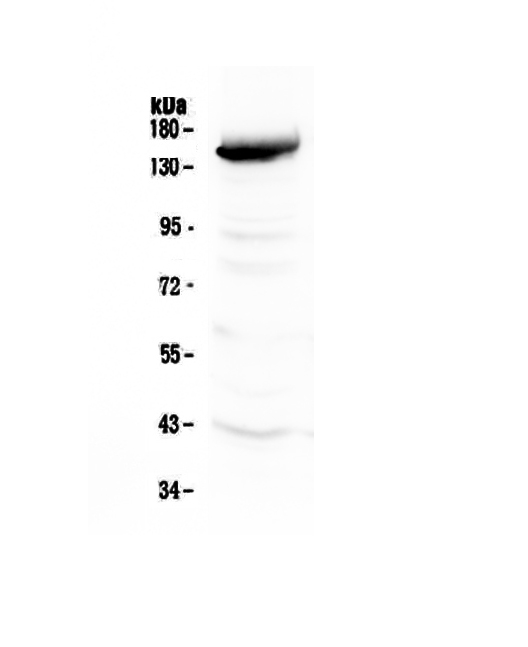
Click image to see more details
Figure 1. Western blot analysis of VEGF Receptor 3 using anti-VEGF Receptor 3 antibody (A01276-3).
Electrophoresis was performed on a 5-20% SDS-PAGE gel at 70V (Stacking gel) / 90V (Resolving gel) for 2-3 hours. The sample well of each lane was loaded with 50ug of sample under reducing conditions.
Lane 1: rat liver tissue lysates.
After Electrophoresis, proteins were transferred to a Nitrocellulose membrane at 150mA for 50-90 minutes. Blocked the membrane with 5% Non-fat Milk/ TBS for 1.5 hour at RT. The membrane was incubated with rabbit anti-VEGF Receptor 3 antigen affinity purified polyclonal antibody (Catalog # A01276-3) at 0.5 μg/mL overnight at 4°C, then washed with TBS-0.1%Tween 3 times with 5 minutes each and probed with a goat anti-rabbit IgG-HRP secondary antibody at a dilution of 1:10000 for 1.5 hour at RT. The signal is developed using an Enhanced Chemiluminescent detection (ECL) kit (Catalog # EK1002) with Tanon 5200 system. A specific band was detected for VEGF Receptor 3 at approximately 153KD. The expected band size for VEGF Receptor 3 is at 153KD.
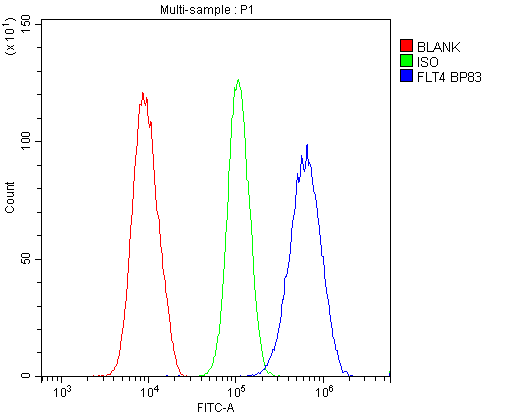
Click image to see more details
Figure 10. Flow Cytometry analysis of U20S cells using anti-VEGF Receptor 3 antibody (A01276-3).
Overlay histogram showing U20S cells stained with A01276-3 (Blue line).The cells were blocked with 10% normal goat serum. And then incubated with rabbit anti-VEGF Receptor 3 Antibody (A01276-3,1μg/1x106 cells) for 30 min at 20°C. DyLight®488 conjugated goat anti-rabbit IgG (BA1127, 5-10μg/1x106 cells) was used as secondary antibody for 30 minutes at 20°C. Isotype control antibody (Green line) was rabbit IgG (1μg/1x106) used under the same conditions. Unlabelled sample (Red line) was also used as a control.
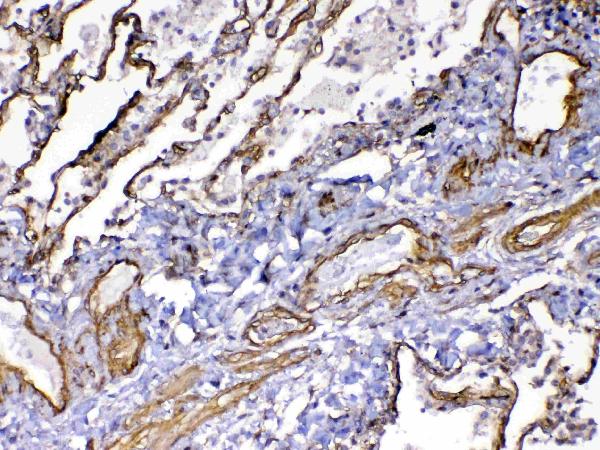
Click image to see more details
Figure 2. IHC analysis of VEGF Receptor 3 using anti-VEGF Receptor 3 antibody (A01276-3).
VEGF Receptor 3 was detected in paraffin-embedded section of human lung cancer tissue. Heat mediated antigen retrieval was performed in citrate buffer (pH6, epitope retrieval solution) for 20 mins. The tissue section was blocked with 10% goat serum. The tissue section was then incubated with 1μg/ml rabbit anti-VEGF Receptor 3 Antibody (A01276-3) overnight at 4°C. Biotinylated goat anti-rabbit IgG was used as secondary antibody and incubated for 30 minutes at 37°C. The tissue section was developed using Strepavidin-Biotin-Complex (SABC)(Catalog # SA1022) with DAB as the chromogen.
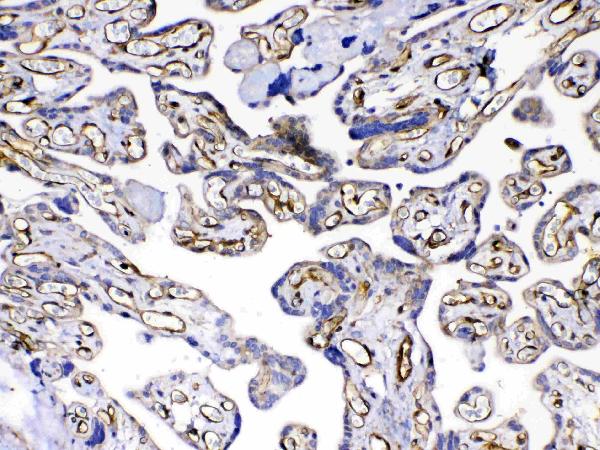
Click image to see more details
Figure 3. IHC analysis of VEGF Receptor 3 using anti-VEGF Receptor 3 antibody (A01276-3).
VEGF Receptor 3 was detected in paraffin-embedded section of human placenta tissue. Heat mediated antigen retrieval was performed in citrate buffer (pH6, epitope retrieval solution) for 20 mins. The tissue section was blocked with 10% goat serum. The tissue section was then incubated with 1μg/ml rabbit anti-VEGF Receptor 3 Antibody (A01276-3) overnight at 4°C. Biotinylated goat anti-rabbit IgG was used as secondary antibody and incubated for 30 minutes at 37°C. The tissue section was developed using Strepavidin-Biotin-Complex (SABC)(Catalog # SA1022) with DAB as the chromogen.
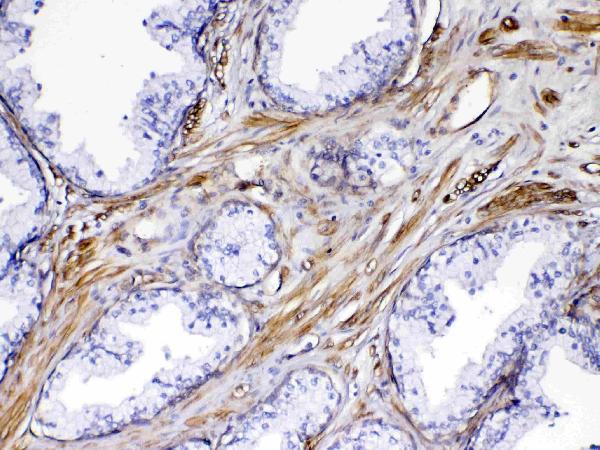
Click image to see more details
Figure 4. IHC analysis of VEGF Receptor 3 using anti-VEGF Receptor 3 antibody (A01276-3).
VEGF Receptor 3 was detected in paraffin-embedded section of human prostatic cancer tissue. Heat mediated antigen retrieval was performed in citrate buffer (pH6, epitope retrieval solution) for 20 mins. The tissue section was blocked with 10% goat serum. The tissue section was then incubated with 1μg/ml rabbit anti-VEGF Receptor 3 Antibody (A01276-3) overnight at 4°C. Biotinylated goat anti-rabbit IgG was used as secondary antibody and incubated for 30 minutes at 37°C. The tissue section was developed using Strepavidin-Biotin-Complex (SABC)(Catalog # SA1022) with DAB as the chromogen.
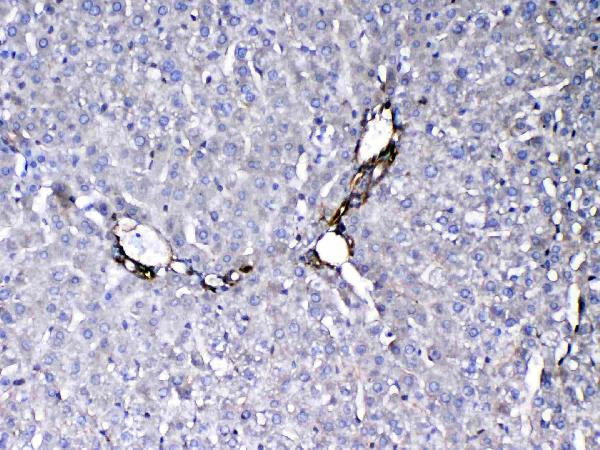
Click image to see more details
Figure 5. IHC analysis of VEGF Receptor 3 using anti-VEGF Receptor 3 antibody (A01276-3).
VEGF Receptor 3 was detected in paraffin-embedded section of rat liver tissue. Heat mediated antigen retrieval was performed in citrate buffer (pH6, epitope retrieval solution) for 20 mins. The tissue section was blocked with 10% goat serum. The tissue section was then incubated with 1μg/ml rabbit anti-VEGF Receptor 3 Antibody (A01276-3) overnight at 4°C. Biotinylated goat anti-rabbit IgG was used as secondary antibody and incubated for 30 minutes at 37°C. The tissue section was developed using Strepavidin-Biotin-Complex (SABC)(Catalog # SA1022) with DAB as the chromogen.
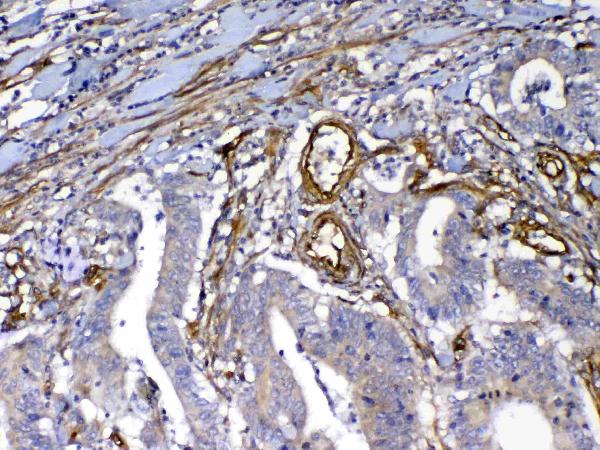
Click image to see more details
Figure 6. IHC analysis of VEGF Receptor 3 using anti-VEGF Receptor 3 antibody (A01276-3).
VEGF Receptor 3 was detected in paraffin-embedded section of human rectal cancer tissue. Heat mediated antigen retrieval was performed in citrate buffer (pH6, epitope retrieval solution) for 20 mins. The tissue section was blocked with 10% goat serum. The tissue section was then incubated with 1μg/ml rabbit anti-VEGF Receptor 3 Antibody (A01276-3) overnight at 4°C. Biotinylated goat anti-rabbit IgG was used as secondary antibody and incubated for 30 minutes at 37°C. The tissue section was developed using Strepavidin-Biotin-Complex (SABC)(Catalog # SA1022) with DAB as the chromogen.
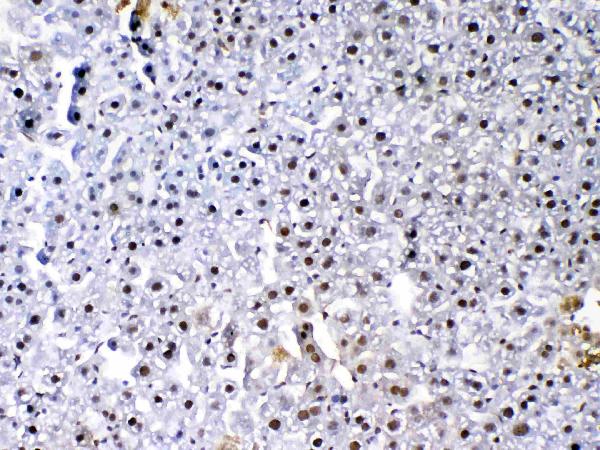
Click image to see more details
Figure 7. IHC analysis of VEGF Receptor 3 using anti-VEGF Receptor 3 antibody (A01276-3).
VEGF Receptor 3 was detected in paraffin-embedded section of mouse liver tissue. Heat mediated antigen retrieval was performed in citrate buffer (pH6, epitope retrieval solution) for 20 mins. The tissue section was blocked with 10% goat serum. The tissue section was then incubated with 1μg/ml rabbit anti-VEGF Receptor 3 Antibody (A01276-3) overnight at 4°C. Biotinylated goat anti-rabbit IgG was used as secondary antibody and incubated for 30 minutes at 37°C. The tissue section was developed using Strepavidin-Biotin-Complex (SABC)(Catalog # SA1022) with DAB as the chromogen.
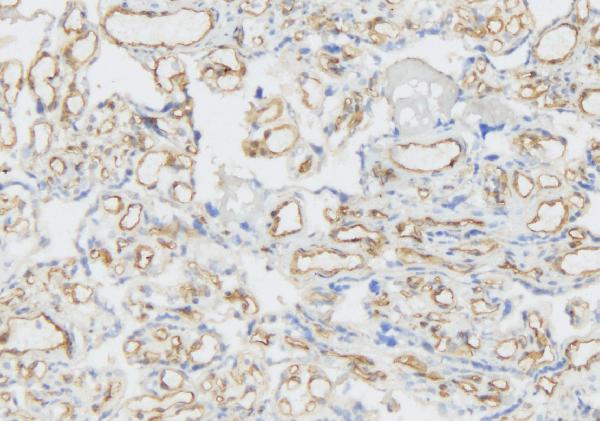
Click image to see more details
Figure 8. IHC analysis of VEGF Receptor 3 using anti-VEGF Receptor 3 antibody (A01276-3).
VEGF Receptor 3 was detected in frozen section of human placenta tissue. The tissue section was blocked with 10% goat serum. The tissue section was then incubated with 1μg/ml rabbit anti-VEGF Receptor 3 Antibody (A01276-3) overnight at 4°C. Biotinylated goat anti-rabbit IgG was used as secondary antibody and incubated for 30 minutes at 37°C. The tissue section was developed using Strepavidin-Biotin-Complex (SABC)(Catalog # SA1022) with DAB as the chromogen.
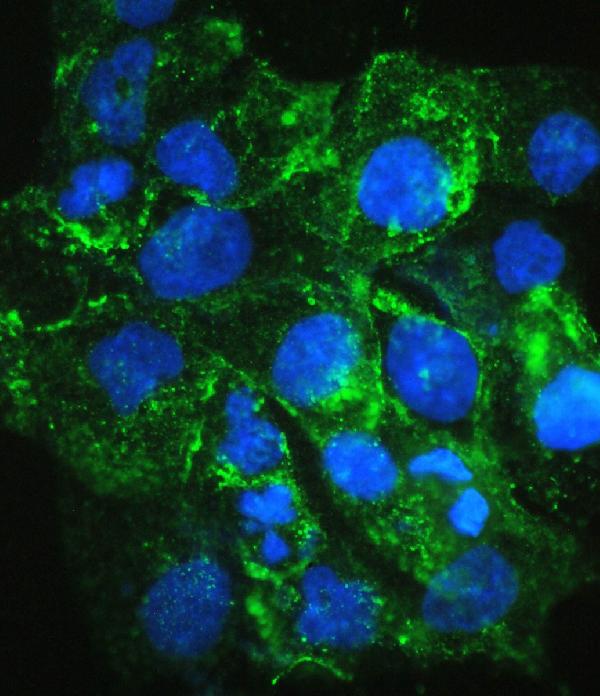
Click image to see more details
Figure 9. IF analysis of VEGF Receptor 3 using anti-VEGF Receptor 3 antibody (A01276-3).
VEGF Receptor 3 was detected in immunocytochemical section of A431 cells. Enzyme antigen retrieval was performed using IHC enzyme antigen retrieval reagent (AR0022) for 15 mins. The cells were blocked with 10% goat serum. And then incubated with 2μg/mL rabbit anti-VEGF Receptor 3 Antibody (A01276-3) overnight at 4°C. DyLight®488 Conjugated Goat Anti-Rabbit IgG (BA1127) was used as secondary antibody at 1:100 dilution and incubated for 30 minutes at 37°C. The section was counterstained with DAPI. Visualize using a fluorescence microscope and filter sets appropriate for the label used.

Click image to see more details
Figure 11. IF analysis of VEGF Receptor 3 using anti-VEGF Receptor 3 antibody (A01276-3).
VEGF Receptor 3 was detected in immunocytochemical section of A431 cells. Enzyme antigen retrieval was performed using IHC enzyme antigen retrieval reagent (AR0022) for 15 mins. The cells were blocked with 10% goat serum. And then incubated with 2μg/mL rabbit anti-VEGF Receptor 3 Antibody (A01276-3) overnight at 4°C. DyLight®488 Conjugated Goat Anti-Rabbit IgG (BA1127) was used as secondary antibody at 1:100 dilution and incubated for 30 minutes at 37°C. The section was counterstained with DAPI. Visualize using a fluorescence microscope and filter sets appropriate for the label used.
Protein Target Info & Infographic
Gene/Protein Information For FLT4 (Source: Uniprot.org, NCBI)
Gene Name
FLT4
Full Name
Vascular endothelial growth factor receptor 3
Weight
10044 MW
Superfamily
protein kinase superfamily
Alternative Names
Vascular endothelial growth factor receptor 3; VEGFR-3; Fms-like tyrosine kinase 4; FLT-4; Tyrosine-protein kinase receptor FLT4; FLT4; VEGFR3 FLT4 CHTD7, FLT-41, LMPH1A, LMPHM1, PCL, VEGFR-3, VEGFR3, FLT4 fms related receptor tyrosine kinase 4 vascular endothelial growth factor receptor 3|Feline McDonough Sarcoma (FMS)-like tyrosine kinase 4|VEGF receptor-3|fms related tyrosine kinase 4|fms-like tyrosine kinase 4|primary congenital lymphedema|tyrosine-protein kinase receptor FLT4
*If product is indicated to react with multiple species, protein info is based on the gene entry specified above in "Species".For more info on FLT4, check out the FLT4 Infographic

We have 30,000+ of these available, one for each gene! Check them out.
In this infographic, you will see the following information for FLT4: database IDs, superfamily, protein function, synonyms, molecular weight, chromosomal locations, tissues of expression, subcellular locations, post-translational modifications, and related diseases, research areas & pathways. If you want to see more information included, or would like to contribute to it and be acknowledged, please contact [email protected].
Specific Publications For Anti-VEGF Receptor 3/FLT4 Antibody Picoband® (A01276-3)
Hello CJ!
A01276-3 has been cited in 4 publications:
*The publications in this section are manually curated by our staff scientists. They may differ from Bioz's machine gathered results. Both are accurate. If you find a publication citing this product but is missing from this list, please let us know we will issue you a thank-you coupon.
Expression levels of VEGF‑C and VEGFR‑3 in renal cell carcinoma and their association with lymph node metastasis
Expression of Cyclooxygenase-2 and Vascular Endothelial Growth Factor-C Correlates with Lymphangiogenesis and Lymphatic Invasion in Human Gastric Cancer
Interleukin-18 suppresses angiogenesis and lymphangiogenesis in implanted Lewis lung cancer
Li C, Fan J, Song X, Zhang B, Chen Y, Li C, Mi K, Ma H, Song Y, Tao X, Li G. Plos One. 2013 Sep 11;8(9):E75388. Doi: 10.1371/Journal.Pone.0075388. Ecollection 2013. Expression Of Angiopoietin-2 And Vascular Endothelial Growth Factor Receptor-3 Cor...
Recommended Resources
Here are featured tools and databases that you might find useful.
- Boster's Pathways Library
- Protein Databases
- Bioscience Research Protocol Resources
- Data Processing & Analysis Software
- Photo Editing Software
- Scientific Literature Resources
- Research Paper Management Tools
- Molecular Biology Software
- Primer Design Tools
- Bioinformatics Tools
- Phylogenetic Tree Analysis
Customer Reviews
Have you used Anti-VEGF Receptor 3/FLT4 Antibody Picoband®?
Submit a review and receive an Amazon gift card.
- $30 for a review with an image
0 Reviews For Anti-VEGF Receptor 3/FLT4 Antibody Picoband®
Customer Q&As
Have a question?
Find answers in Q&As, reviews.
Can't find your answer?
Submit your question
3 Customer Q&As for Anti-VEGF Receptor 3/FLT4 Antibody Picoband®
Question
We are currently using anti-VEGF Receptor 3/FLT4 antibody A01276-3 for mouse tissue, and we are content with the ELISA results. The species of reactivity given in the datasheet says human, mouse, rat. Is it possible that the antibody can work on feline tissues as well?
Verified Customer
Verified customer
Asked: 2020-01-02
Answer
The anti-VEGF Receptor 3/FLT4 antibody (A01276-3) has not been validated for cross reactivity specifically with feline tissues, though there is a good chance of cross reactivity. We have an innovator award program that if you test this antibody and show it works in feline you can get your next antibody for free. Please contact me if I can help you with anything.
Boster Scientific Support
Answered: 2020-01-02
Question
My question regards to test anti-VEGF Receptor 3/FLT4 antibody A01276-3 on human plasma for research purposes, then I may be interested in using anti-VEGF Receptor 3/FLT4 antibody A01276-3 for diagnostic purposes as well. Is the antibody suitable for diagnostic purposes?
Verified Customer
Verified customer
Asked: 2019-12-23
Answer
The products we sell, including anti-VEGF Receptor 3/FLT4 antibody A01276-3, are only intended for research use. They would not be suitable for use in diagnostic work. If you have the means to develop a product into diagnostic use, and are interested in collaborating with us and develop our product into an IVD product, please contact us for more discussions.
Boster Scientific Support
Answered: 2019-12-23
Question
Does anti-VEGF Receptor 3/FLT4 antibody A01276-3 work on canine WB with plasma?
Verified Customer
Verified customer
Asked: 2017-09-06
Answer
Our lab technicians have not validated anti-VEGF Receptor 3/FLT4 antibody A01276-3 on canine. You can run a BLAST between canine and the immunogen sequence of anti-VEGF Receptor 3/FLT4 antibody A01276-3 to see if they may cross-react. If the sequence homology is close, then you can perform a pilot test. Keep in mind that since we have not validated canine samples, this use of the antibody is not covered by our guarantee. However we have an innovator award program that if you test this antibody and show it works in canine plasma in WB, you can get your next antibody for free.
Boster Scientific Support
Answered: 2017-09-06





